By Frances Allen and Reuben Solomon, public law barristers at Goldsmith Chambers
References in square brackets are to paragraphs in the Supreme Court judgment
Issue in the appeal
The issue for the Supreme Court was to determine whether:
“the Divisional Court and District Judge Cadbury were correct to decide that the two offences charged under regulation 30(1)(g) of the Welfare of Animals at the Time of Killing (England) Regulations 2015 (SI 2015/1782) (“WATOK Regulations 2015”) – namely the breach by HPFPL, as a business operator, of, first, article 3(1) and, secondly, article 15(1), Annex III, point 3.2, of Regulation (EC) No 1099/2009 on the protection of animals at the time of killing (“the EU Regulation”) – are offences of strict liability so that negligence by the business operator does not have to be proved.” [8]
Held
The two offences in issue are offences imposing strict liability on the business operator. There is no requirement to prove negligence [56].
The Court agreed with Jay J who said at para 88 of his judgment in the Divisional Court:
“[T]he EU Regulation … should be seen as setting forth a comprehensive code or rule-book which must be complied with by the business operator at all material times. On the facts of the present case, there was a strict obligation to sever the main arteries systematically, and a concomitant strict obligation to spare these birds avoidable pain.”
Background
Highbury Poultry Farm Produce Ltd (“HPFPL”) operates a poultry slaughterhouse in Shropshire under the approval of the Food Standards Agency. The average throughput is 75,000 chickens per day, equating to 19.5m or so chickens per annum. The birds have their legs shackled to a moving line and are then submitted to a number of sequential processes, including stunning, bleeding and scalding. On each of 31 August, 12 September and 5 October 2016 a chicken went into the scalding tank (where its feathers would be removed) while still alive because, after stunning, its neck had not been properly cut by a certificated operative.
HPFPL was charged with two offences in respect of each incident under Reg 30(1)(g) of WATOK, namely contravention of Article 3(1)of the EU Regulation which requires that animals should be spared avoidable pain, distress or suffering during their killing and related operations and contravention of Article 15(1), which requires a business operator to comply with the operational rules for slaughterhouses laid down in Annex III of the Regulation including point 3.2 setting out the requirements for the bleeding of animals.
At the Magistrates’ Court before the District Judge, HPFPL raised two preliminary points of law. Firstly, whether the Crown was required to prove mens rea (knowledge of the factual circumstances constituting the offence) and secondly, whether it had to prove a culpable act or omission on the part of the business operator.
District Judge Cadbury (DJ) held that offences under regulation 30(1)(g) are ones of strict liability and do not require any proof of mens rea or culpability on the part of HPFPL.
The DJ then stated a case (‘case stated’)* seeking the opinion of the Divisional Court* on whether this ruling was in accordance with the law. HPFPL also brought judicial review proceedings on the same point as there was uncertainty about the correct procedure where the legal issue had been raised on a preliminary point of law and there had been no final determination of guilt. The Divisional Court determined that the appropriate procedure in this case should be by way of judicial review, granted permission but dismissed the claim.
The Divisional Court, agreeing with DJ Cadbury, concluded that offences under regulation 30(1)(g) are offences of strict liability, and that proof of knowledge or culpability on the part of HPFPL as business operator is not required.
HPFPL appealed, was granted permission and in June 2020, the appeal was heard by the Supreme Court by way of a ‘leapfrog’ appeal*, by-passing the Court of Appeal.
Judgment of the Supreme Court
Judgment was given by Lord Burrows (with whom Lord Reed, Lord Lloyd-Jones, Lord Kitchin, and Lord Hamblen agreed).
The Supreme Court first considered the relationship between the EU Regulation 1099/2009 and the domestic regulations (WATOK regulations 2015) which implemented the EU Regulation in England. The Court found that EU Regulation 1099/2009 laid down in detail the duties imposed with the WATOK regulations setting criminal penalties for a breach of those duties. Although under Article 23 member states have a discretion as to the penalties to impose (whether criminal, civil or administrative) there is no discretion to lower the standards required by the EU Regulation so if the EU Regulation imposes strict liability a member state has no discretion to set the requirement to be met to prove infringement as negligence rather than strict liability [14 – 15].
As set out by the Court at paragraph 15 “if the EU Regulation imposes strict liability, the domestic regulation must (as a matter of EU law) do the same;” The Court was bolstered in this view by reference to regulation 30(1)(g) itself which states: “It is an offence to contravene…a provision of the EU regulation specified in Schedule 5”.
This meant that for HPFPL to succeed they would have to establish that negligence rather than strict liability is required under the EU Regulation 1099/2009. [16]
Whether strict liability is required under the EU Regulation involves interpretation of the EU Regulation in accordance with EU law principles with a strong emphasis on seeking to ensure that the interpretation of the words fulfils the purpose of the legislative provision and, more generally, the purposes of the EU. The Court stated that it was important to clarify, so that
there is no doubt, that the imposition of strict liability in the context of criminal law is not contrary to EU law.[28]
The Court then turned to the offences themselves and found:
Article 15(1) – the relevant words impose strict liability, business operators “shall ensure” that the operational rules are complied with such that the “two carotid arteries or the vessels…shall be systematically severed”. There is no hint that business operators shall be liable only if the operational rules are intentionally or negligently infringed. This interpretation is supported by the purpose of the provision as strict liability imposes a clear and easily enforceable standard and is therefore in line with a principle goal of uniformity across the EU [33-34].
Article 3(1) – the relevant words of article 3(1) impose strict liability: animal “shall be spared” avoidable pain, distress or suffering”. The requirement that the pain, distress or suffering is “avoidable” would be met where the business operator has contravened a specific operational rule (as here) which is designed to ensure the avoidance of pain, distress or suffering [39]. Although Recital (2) to the EU Regulation, mentions suffering being induced “by negligence or intention”, this does not affect the wording of article 3(1). Negligence or intention are examples of the ways in which a breach of the EU Regulation induces suffering, but they do not form an exhaustive list [48]. The recitals to an EU regulation, although of considerable importance, cannot be interpreted in such a way as to contradict the clear wording of that regulation [49].
What next
Having determined the preliminary issue raised before District Judge Cadbury the case will now go back to the Magistrates’ Court where the criminal proceedings will continue before District Judge Cadbury to be finally determined. However as noted by Mr Justice Jay J in the Divisional Court, at paragraph 54 of his judgment, if the test is strict liability then:
“… may be that HPFPL has no defence to these charges;”
Two matters to note in the Judgment
There was no appeal against the decision of the Divisional Court that the correct procedure was judicial review and not by way of case stated [7].
The Court found in respect of Article 3(1) that the fact the two carotid arteries or the vessels from which they arise were not systematically severed does not mean that the bird has inevitably experienced pain, distress or suffering. If there is any doubt it will be a matter for the prosecution to prove in the normal way [41].
Significance of this Judgment
The significance of this Judgment is the impact on enforcement of these Regulations and being able to bring to account business operators who infringe the Regulations. At paragraph 34 the Court identified the difficulty with enforcement if it were necessary to prove a negligent standard rather than strict liability. If it were the case that the offence would require negligence of an operator with blame being attached vicariously to the business operator then in cases where the operations are mechanical there are serious difficulties posed in being able to identify the relevant operative.
*Case stated is a type of appeal from a Magistrates Court to the Divisional Court of the High Court on a point of law. The District Judge can refer a case to the Divisional Court for an opinion about whether he or she was wrong in the application of the law or in excess of their jurisdiction.
*[2018] EWHC 3122 (Admin)
*This is a procedure used only exceptionally. It is reserved for cases heard in the High Court which raise ‘a point of law of general public importance.’

![R (on the application of Highbury Poultry Farm Produce Ltd) (appellant) v Crown Prosecution Service (respondent) UKSC [2020] 39](https://news.alaw.org.uk/wp-content/uploads/2021/10/News-Blog-Image-25.png)
















